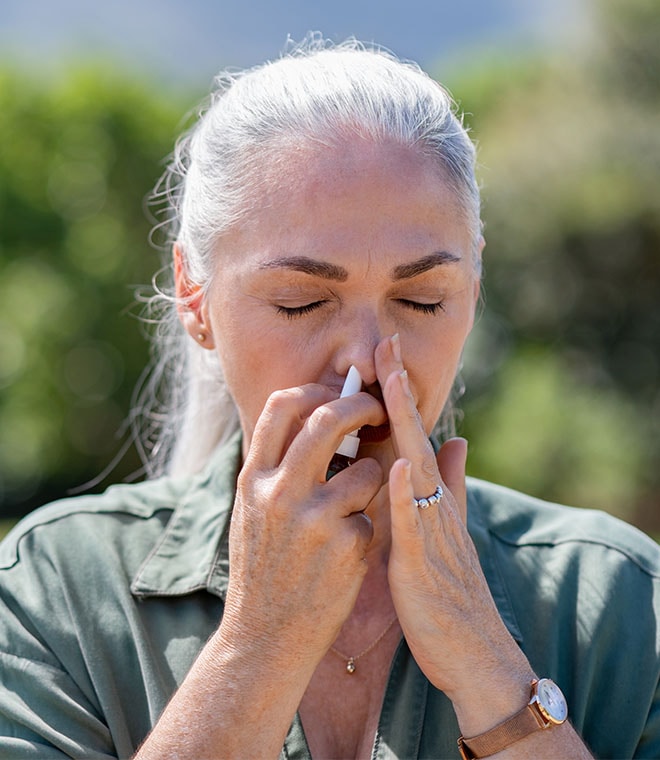Health
What is the difference between coronavirus (COVID-19) symptoms and seasonal allergies?
Clinically reviewed and updated by Nora Laberee, MPH Jun 11, 2024 • 6 min
Seasonal allergies and respiratory infections like COVID-19 have some symptoms in common, but there are key differences — here's what you should know.
COVID-19 symptoms vs. seasonal allergies
COVID-19 is caused by a virus that can spread from person-to-person through respiratory droplets when an infected person coughs or sneezes. Seasonal allergies, on the other hand, are typically caused by outdoor allergens such as pollen from trees, grasses, and weeds, and are not contagious. Common symptoms of allergies like sneezing, runny nose and itchy eyes are not common symptoms of COVID-19. Also, a fever is not usually an allergy symptom, but it is common with many respiratory infections, including COVID-19.
COVID-19
Seasonal allergies
What is it?
Contagious disease from a virus
Symptoms may include:*
Shortness of breath, cough, fever
Symptoms may appear:
2–14 days after exposure
What is it?
Allergy to pollen and/or outdoor mold spores (not contagious)
Symptoms may include:
Sneezing, itchy eyes, runny nose (no fever)
Symptoms may appear:
Suddenly after exposure to the allergen
*This list is not all-inclusive. Contact your healthcare provider if symptoms are concerning.
Symptoms of COVID-19
According to the Centers for Disease Control and Prevention (CDC), people with COVID-19 have experienced mild to severe symptoms within 2–14 days after exposure to the virus.
Common COVID-19 symptoms include:
- Fever
- Cough
- Shortness of breath
Older adults and people who have severe underlying medical conditions, like heart disease, lung disease or diabetes, seem to be at higher risk for developing more serious complications from COVID-19 illness. If you develop emergency warning signs for COVID-19, get medical attention immediately.
Emergency warning signs include:*
- Trouble breathing
- Persistent pain or pressure in the chest
- New confusion or inability to arouse
- Bluish lips or face
*This list is not all-inclusive. Please contact your healthcare provider for any other symptoms that are severe or concerning.
Testing for COVID-19
If you have symptoms of COVID-19 and want to get tested, contact your local pharmacy or healthcare provider. You may choose to use an at-home test or get tested at a pharmacy or healthcare facility. For more information about testing, see the CDC's guidance for testing for COVID-19. At-home COVID-19 tests are available for purchase over the counter.
What to do if you have symptoms of COVID-19
People who are mildly ill with COVID-19 are able to recover at home. See tips below and visit the CDC's guidelines for the most up-to-date information.
- Stay home and away from others except to get medical care
As much as possible, stay in your own room and away from other people. - Wear a face mask
Wear a face mask when you are around other people (for example, sharing a room or vehicle) and before you enter a healthcare provider's office to help prevent spreading the virus - Cover coughs & sneezes
Cover your mouth and nose with a tissue when you cough or sneeze, throw used tissues in a lined trash can and immediately wash your hands with soap and water for at least 20 seconds. If soap and water are not available, clean your hands with an alcohol-based hand sanitizer that contains at least 60% alcohol. - Wash your hands often
Wash your hands often with soap and water for at least 20 seconds. This is especially important after blowing your nose, coughing, sneezing, going to the bathroom, and before eating or preparing food. - Avoid sharing personal items
Do not share dishes, drinking glasses, cups, eating utensils, towels or bedding with other people in your home. - Clean high-touch items and surfaces every day
Disinfect high-touch surfaces in your isolation area (sick room and bathroom) every day; let a caregiver clean and disinfect high-touch surfaces in other areas of the home. - Monitor symptoms
Follow care instructions from your healthcare provider and local health department.
What to do if you have seasonal allergies
Avoiding known allergens can help keep allergy symptoms at bay. If you have seasonal allergies due to pollen, pay attention to the pollen counts. On days when the pollen count is high, stay indoors as much as possible and keep windows closed. Also, be sure to change your clothes and shower when you come in from outside to remove pollen.
If you have seasonal allergies, it can also be helpful to have allergy medications available, over the counter (OTC) or by prescription from your doctor. Your doctor or pharmacist can recommend allergy medications specific to your needs.
If you believe you have allergies, see an allergist (a doctor who specializes in diagnosing and treating allergies, asthma and immunologic disorders). They can figure out exactly what you're allergic to and create a treatment plan to help ease your symptoms.
Clinically reviewed and updated June 2024.
Sources:
- https://www.enthealth.org/conditions/sore-throats/
- https://www.cdc.gov/coronavirus/2019-ncov/symptoms-testing/symptoms.html
- https://www.cdc.gov/coronavirus/2019-ncov/hcp/index.html
- https://acaai.org/allergies/allergic-conditions/seasonal-allergies/
- https://medlineplus.gov/ency/article/000005.htm
- https://www.cdc.gov/coronavirus/2019-ncov/prevent-getting-sick/prevention.html



